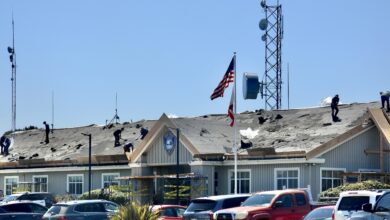City, county hear they have special wave energy powers
A city-county forum on wave energy enthralled Dr. Richard Miller Saturday in Fort Bragg, the hours of fast-paced discussion panels changing his mind.
“I entered the forum an advocate of wave energy and exited a skeptic,” said Miller, host of a show about health on local public radio.
“Energy can be extracted from the waves but now the question is on all of our tables: at what price?”
For many of about 150 people who attended the wave energy forum, it was their best chance yet to determine the cost and benefits of wave energy and to match the players to a confusing and fast-changing program.
“The City and Mendocino County did a great job in organizing the meeting. The significance to me was having everyone in the same room discussing wave energy topics, and meeting and understanding who the players are,” said Elizabeth Mitchell, a retired National Oceanic and Atmospheric Administration attorney now living in Fort Bragg.
Scientists, fishermen, entrepreneurs and bureaucrats explained what could emerge off the coast in a few years, giving specifics about what arrays might look like based on working proposals in Oregon.
A brand new wave-wind energy proposal in Washington would be 8 to 10 miles long.
Locally, buoys would be placed in rows parallel to shore and 2 and a half miles out. Each row would take 3 percent of the wave energy. Four rows are considered optimal, the audience heard.
“The size and scale of the proposed devices is astonishing and alarming,” said Rachel Binah, an anti-offshore oil exploration activist.
One panel of regulators explained the many layers of protection provided any project that goes into the ocean, comforting some critics.
“The most interesting comments came from the fishermen. I was impressed by their open-mindedness,” said Laura Welter, head of a local non-profit agency.
“They know as much as anybody else that we need to look at alternative energy sources. They just want to protect that beautiful resource, and the creatures that live there. Developers of wave energy will be smart if they include fishermen in the process from the very start,” Welter said.
There was little presented to settle unease about how locals can steer the process as it goes forward.
“After all that was said, we still don”t know what the public input process will be. That whole issue was side-stepped at the forum. They all appear to be making this up by the seat of their pants,” said Binah.
One evidence of this was the scramble for a comprehensive map of proposed projects that Binah and others have pleaded for.
NOAA assembled such a map, but even fellow federal agencies were having trouble locating all the FERC applications to help NOAA put them on the map. FERC offers no map.
“We are beginning to see maps of the nationwide scope of wave energy projects for the first time. It is clear that FERC”s preliminary permits are starting to blanket both coasts,” said Mitchell.
A brand new series of proposals in Alaska by a Texas company offers local towns local control.
Federal, city and county officials were among those who sought help from this reporter finding the docket numbers for recent projects that are very hard to find on the FERC Website. Implications of the difficult search process are serious. Without those docket numbers, the official intervention deadline could pass.
Three different approaches to wave energy regulation emerged in a panel that involved the Federal Energy Regulatory Commission, Minerals Management Service and California State Lands Commission.
The crowd heard that FERC and MMS have settled their differences over which federal agency is in charge in an agreement called an MOU, or Memo of Understanding. That document is expected to be released in February.
Many listeners were intrigued by Maurice Hill”s, of MMS, explanation of the MMS process, which calls for competitive bidding of wave or wind energy leases and direct negotiations with anyone. FERC awards its wave energy territory on a first-come first-served basis, creating issues such as the GreenWave filing off Mendocino, in which no investment beyond the filing fees is evident.
“It is clear that MMS has been meticulous in observing rulemaking and environmental study requirements for its national program, while FERC has not,” said Mitchell, who has filed documents objecting to the FERC process.
“The process for local public input and persuasion remains unclear. Local and small business preferences are apparently left to the discretion of individual energy developers,” said Mitchell.
The organizing local municipalities found out from Stephen Bowler of FERC that they have a preference under the Federal Power Act over other kinds of wave energy filers. Officials from both municipalities planned to look into how this could work.
The City/County coordinating committee that organized the Wave Energy Forum plans to get together later this week to debrief and strategize about what”s next, said Fort Bragg City Manager Linda Ruffing.
“In terms of formal actions, I believe that both the City and County should file Motions to Intervene on the GreenWave preliminary permit application,” said Ruffing.
“I expect that we”ll also want to take some more proactive steps, such as helping to establish a local stakeholders group (akin to Lincoln County”s Fishermen Interested in Natural Energy). For me, Saturday”s proceedings really drove home the point that wave energy is a big deal” and it”s imperative that the City (and the community) stay on top of it and make certain that our concerns are addressed,” Ruffing said.
FERC”s Bowler said the agency is considering how to respond to persistent calls that it engage in rulemaking. Bowler emphasized that his agency has a mandate to put the need to develop the energy on an equal footing with all other concerns.
“This is different than the mission of the caretaking agencies,” he said.
For Binah, that was more than enough reason for locals to have real control of the energy off their shores.
“The City and County must be in charge of protecting our coast because even though there are many layers of protection” agencies,” if FERC takes over, they could be swept away in this potential “gold rush,” Binah said.
California”s State Lands Commission does not believe that the federal government can authorize anything in the ocean without state signoff. State Lands emphasized again that neither FERC nor any of the applicants, such as PG&E, GreenWave and Ocean Power Technologies, have filed any applications with the state and must do so. The application could initiate a California Environmental Quality Act review process that would take more than a year and in which State Lands would act as the lead agency, it was revealed at the forum.
Another interesting point that emerged in discussions this reporter had with several official participants at the forum was that PG&E could use eminent domain powers to push a wave energy plant through, if it wanted to, which might allow the utility the ability to circumvent some state processes that FERC itself might be subject to. The utility has promised to gain community support and has promised an open process and dialogue.
Three representatives of PG&E were in Fort Bragg all day for the event. Bill Toman was introduced as the new project manager. The company has been much more open with the community than others seeking local preliminary permits, such as Chevron, GreenWave and California Wave Energy Partners.
There was no opportunity for the public to speak, which for once, seemed fine with the audience. Most of the speakers had to quit before they were finished with presentations, as the program was kept on a fast track. One man began shouting from the back of the room during one panel discussion and was silenced by Fort Bragg Mayor Doug Hammerstrom.
Industry representatives said a whopping 100 megawatts could be generated in three-quarters of a square mile of ocean. While PG&E has laid claim to 68 square miles off the coast, the utility plans to utilize only a small portion of that area to develop wave energy.
Steve Kopf of Ocean Power Technologies said the local process could work, if local people stay involved. He said he had been involved in more than 20 meetings similar to the Saturday seminar.
A gray whale study, the first in many years to count the big mammals, is one of the first benefits of wave energy study investment, Oregon representatives said.
For Dr. Miller, the forum created far too many worries.
“Federal experts are telling us that the wave energy industry may well ruin the commercial and sport fishing business, disrupt and perhaps kill the ecosystem of the ocean, spoil the scenic view of our coast line, leave huge amounts of wreckage and industrial waste, open the door for removal of the moratorium on coastal oil and gas drilling and most importantly dramatically lessen the quality of life for coastal inhabitants.”
But what about the need for more clean energy?
“Perhaps old folks like me best lead the way towards a lot more local bicycle usage..or should I say trikes?” Miller said.




